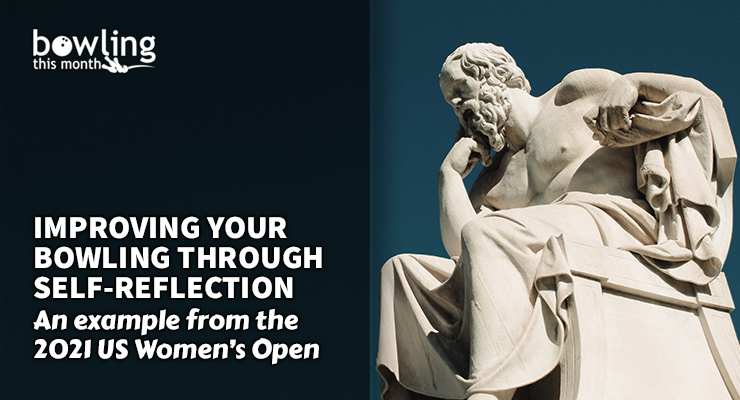Once a tournament is finished, do you take the time to think about your performance? Not the result, but your performance? Taking the time to reflect on how you executed, your mental game, and your lane play choices can be very helpful. You can improve your bowling game by:
- evaluating what went well so you can repeat it, and;
- evaluating what needs improvement so you can have a purpose to your training.
Depending on the event, I personally take anywhere from five minutes for a small local tournament to a few days for a PWBA major to reflect on my performance. Over the course of this article, I’ll discuss the general principles of doing a reflection (also called a self-debrief) exercise, and review my experience at the 2021 US Women’s Open (USWO) as an example of how to apply these elements.
Objective review
First, there is a lot of value in dividing up your reflection/self-debrief into two categories: objective and subjective measures.
The objective review includes things you can track numerically. It’s not about interpretation. Here is what I track: strike percentage, spare conversions (single-pin and multi-pin), and number of splits. I personally use the PinPal app to track my frames and games, but there are several other apps out there that can do the same thing.
Here’s an example of a table showing this information from my 2021 USWO, which we’ll take a closer look at later in the article.
Day Strike % Single-Pins Multi-Pins Splits Average 1 50% 24/24 10/12 1/6 205.5 2 36% 30/31 10/16 1/8 188.1 3 55% 23/24 8/8 0/7 219.0 4.1 34% 24/25 12/18 1/12 179 4.2 53% 20/20 6/9 0/9 213.5 5.1 62% 14/15 5/5 3/11 220.4 5.2 50% 13/14 11/15 2/14 188.8(Note that 4.1 represents day 4, block 1; 4.2 is day 4, block 2; etc.)
Subjective reflection
It is important to evaluate not only the objective measures mentioned above, but also the subjective measures since a high percentage of our performance is predicated on our mindset, thought process, and how we handle adversity. I would further divide the subjective measures into three categories: state of mind, physical state, and tactical choices.
State of mind
One technique I was taught through the Team Canada program for evaluating my state of mind is the “traffic lights” system. You simply rate the percentage of time you were in a “green,” “yellow,” or “red” state of mind on a scale of 0 to 100 percent, with a total block equaling 100 percent. Green indicates feeling in the flow, meaning everything is going well; you feel confident in both shotmaking and making the right adjustments. Yellow indicates slight hesitation, frustration and/or distraction. Finally, red represents a borderline meltdown and/or complete rage.
I can honestly and thankfully say that I hardly ever fall into the red zone anymore. However, it is still quite easy for me to slip into yellow. Even though we are putting numbers on this measurement, it is still subjective and open to interpretation. We have to be ...
This article is only available to Bowling This Month subscribers. Click below to get instant access to this article and all of our other premium instructional content.
Subscribe to Bowling This Month
Already a Bowling This Month subscriber? Click here to log in.
Image Credits: Socrates statue image (©iStock.com/Panagiotis Maravelis) is licensed for use by BTM and is the copyrighted property of its original creator.
